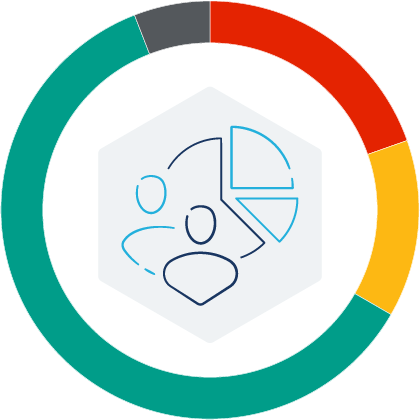Workforce Data
What Are Workforce Data?
For the purposes of the Index, workforce data include the state-level collection and use of key data on the size, characteristics, and working conditions of the early childhood workforce.
The absence of good data allows anecdote and bias to drive policy decisions. Without quality comprehensive data, it’s impossible to answer key policy questions, much less develop estimates of the level of public funding needed to recruit and retain a qualified ECE workforce.1 McLean, C., & King, C. (2019, October 10). A Workforce Data Deficit Hinders Improved Preparation, Support, and Compensation of Early Childhood Educators. Center for the Study of Child Care Employment, University of California, Berkeley. https://cscce.berkeley.edu/a-workforce-data-deficit-hinders-improved-preparation-support-and-compensation-of-early-childhood-educators/.
Nationwide, leaders lack answers to critical questions about educators who work with young children. Questions like: Who constitutes the early childhood workforce throughout the United States? How does the ECE workforce vary by state, Tribe, and territory? What are their current education and compensation levels? Which educators receive crucial supports like paid time for planning and reflection to improve their practice in the classroom? Are documented racial and other inequities in the field being eliminated, exacerbated, or remaining stagnant?2 Moving forward, it is critical that state data systems allow for nuanced analyses in order to disrupt inequities: at the national level, wage disparities exist for various groups within early care and education, including educators of color and infant-toddler teachers, as well as between educators working in schools and those working in community-based settings. See Whitebook, M., McLean, C., Austin, L.J.E., & Edwards, B. (2018). Early Childhood Workforce Index – 2018. Center for the Study of Child Care Employment, University of California, Berkeley. https://cscce.berkeley.edu/topic/early-childhood-workforce-index/2018/.
States, Tribes, and territories are routinely unable to answer these basic questions because data about the early childhood workforce are often limited in reach and scope.3 Whitebook, M., McLean, C., & Austin, L.J.E. (2018). The Workforce Data Deficit. Center for the Study of Child Care Employment, University of California, Berkeley. https://cscce.berkeley.edu/the-workforce-data-deficit/. This challenge is closely linked to public funding: public dollars only reach a fraction of ECE programs, and the same is often true of state data collection on the ECE workforce. Consequently, states, Tribes, and territories struggle to assemble a picture of their ECE workforce. Moreover, there is also no comprehensive, longitudinal data source for the United States on par with data collected on the K-12 teaching workforce.4 For example, the School and Staffing Survey (SASS), now the National Teacher and Principal Survey (NTPS) provides an ongoing means of examining the characteristics and work environment of the K-12 workforce across the United States, see National Center for Education Statistics. (n.d.). The National Teacher and Principal Survey. Institute of Education Sciences. https://nces.ed.gov/surveys/ntps/. There are bright spots, such as the National Survey of Early Care and Education (NSECE) and the National Workforce Registry Alliance (NWRA) Workforce Dataset (see the box on National ECE Workforce Data). However, individual states, Tribes, and territories remain the core drivers of ECE workforce data collection. For the 2024 Index, we collaborated with NWRA to provide the most up-to-date data on registries throughout the country.
States are increasingly recognizing the value of ECE workforce data for effective governance. Policymakers are tapping into resources like the Child Care Development Fund (CCDF) or the Preschool Development Grant Birth through Five (PDG B-5) to fund data collection. During the pandemic, states with an established registry were better positioned to understand the needs of the ECE workforce and funnel resources to them.5 Funding source data provided by the National Workforce Registry Alliance. Many other communities, however, were not able to identify and reach members of their ECE workforce directly, and as the sector recovers, many states struggle to determine the reach of pandemic relief programs.
These state actions highlight what is possible, but they also underscore the need for a long-term commitment to an ECE workforce data strategy, including the funding, partnerships, and infrastructure necessary to sustain it.

National ECE Workforce Data
There are two primary national sources of data specific to early care and education. The National Survey of Early Care and Education (NSECE) is the only data source that provides a representative sample of early educators.
National Survey of Early Care and Education
Conducted by NORC at the University of Chicago, the National Survey of Early Care and Education (NSECE) provides a nationally representative, detailed portrait of the ECE workforce, along with data on the families who rely on early care and education.1For more information on the NSECE, see U.S. Department of Health and Human Services, Administration for Children and Families, Office of Planning, Research, and Evaluation. (2024). National Survey of Early Care and Education. https://www.acf.hhs.gov/opre/research/project/national-survey-of-early-care-and-education-2019. The survey is funded by the Administration for Children and Families. The first survey took place in 2012, followed by another round in 2019. The survey is in the process of its third round of data collection in 2024. The design encompasses both center- and home-based early educators, including those who are not required to be licensed or registered in their particular state. However, due to the sample size, the data do not allow for comprehensive state-level analysis in most cases.
National Workforce Registry Alliance Dataset
In 2012, the National Workforce Registry Alliance (NWRA) set the ambitious goal of creating a national dataset by stitching together data from each state’s workforce registry. This endeavor included setting standards for core data elements, followed by an in-depth process known as Partnership Eligibility Review (PER) to assess data quality. NWRA releases a report on the data every two years, and researchers may submit a request for data to conduct secondary analyses.2The National Workforce Registry Alliance. (2023). The Early Childhood Workforce Dataset. https://www.registryalliance.org/our-work/data/. The expansion of the NWRA dataset and corresponding PER process has encouraged growth and rigor in registries across the country. As of 2023, 16 states representing 642,130 professionals participated, with more states undergoing assessment to be incorporated in the dataset.3The National Workforce Registry Alliance. (2022). 2021 Alliance Longitudinal Workforce Report. https://www.registryalliance.org/category/data/. However, NWRA’s dataset relies on each state to maintain a commitment to data quality coverage of the full ECE workforce. To achieve a complete national dataset, the United States would need to either fund all states to meet the PER standard or provide funding to create a singular database for all early educators.
In addition to the NSECE and NWRA datasets, there are two other national data sources that emerged during the pandemic.
National Association for the Education of Young Children Surveys
During the COVID-19 pandemic, the National Association for the Education of Young Children (NAEYC) began conducting national surveys of the ECE workforce. Through their broad membership, NAEYC’s research team reaches a non-random sample of more than 10,000 early educators in a single survey, allowing for both national analysis and state-level disaggregation. The sample is not nationally representative, but they use a probability proportional to size (PPS) methodology to align their sample with the share of early educators by state. The purpose of the surveys differs somewhat from NSECE and other national sources: each survey explores policy-driven themes. For instance, NAEYC’s January 2024 survey focused on the expiration of pandemic relief funding and the rising costs of liability insurance.4National Association for the Education of Young Children. (2024). NAEYC ECE Workforce Surveys. https://www.naeyc.org/ece-workforce-surveys.
RAPID Survey Project
A new source of national ECE workforce data is in development with the RAPID Survey Project led by the Stanford Center on Early Childhood. RAPID emerged during the pandemic in 2020 as a philanthropy-funded research initiative. RAPID began by assembling a national dataset of parents with children under age six, with monthly surveys providing a running record of material hardship, well-being, and child care usage.5RAPID Survey Project. (n.d.). Latest Data & Trends. Center on Early Childhood, Stanford University. https://rapidsurveyproject.com/latest-data-and-trends. In 2021, RAPID began building a national ECE workforce dataset, allowing them to track similar topics over time for approximately 3,500 early educators. While the data do not match NSECE’s status as statistically representative, the household and provider samples continue to grow and allow researchers to monitor changes month over month.6RAPID Survey Project. (n.d.). About Us. Center on Early Childhood, Stanford University. https://rapidsurveyproject.com/aboutus.
Tenets of Strong ECE Workforce Data
While there are many approaches to gathering data, nearly all states collect at least some ECE workforce data via either a registry, a survey, or both. Registries and surveys are not mutually exclusive. Given their respective strengths and limitations, both tools can be especially powerful when used together to develop a richer, more comprehensive understanding of the ECE workforce. This effort might include committing ongoing funds for a statewide registry—which captures demographics, wages, and professional learning for all early educators working directly with children—then conducting nimble, policy-driven surveys to tackle complex issues like well-being and turnover.
Workforce Registries: An ECE workforce registry is a multifaceted resource intended to serve as a hub for the professional development and support of the ECE workforce. Registries are typically funded at the state level using federal funding from CCDF or PDG B-5.6 The National Workforce Registry Alliance. (n.d.). Professional Registries. https://www.registryalliance.org/about-us/workforce-registries/; The National Workforce Registry Alliance. (2024). 2023 Workforce Registry Landscape Report. https://www.registryalliance.org/wp-content/uploads/2024/02/KBB-FINAL-Copy-of-ECE-Workforce-Registry-Landscape_2023-5.pdf. In addition to connecting early educators to training and resources, registries gather a wealth of data on more than 1 million active members of the ECE workforce. The types of data that are required vary state by state, but there is momentum towards standardization (see National ECE Workforce Data). A registry with adequate funding and staffing can generate valuable data on the demographics, education, and employment status of the ECE workforce.7 See Kipnis, F., & Whitebook, M. (2011). Workforce Information: A Critical Component of Coordinated State Early Care and Education Data Systems. Center for the Study of Child Care Employment, University of California, Berkeley. https://cscce.berkeley.edu/publications/report/workforce-information-a-critical-component-of-coordinated-state-early-care-and-education-data-systems/. However, registry participation is voluntary for many members of the ECE workforce. As a result, the data may represent only certain segments of the workforce (for instance, early educators working in programs participating in a quality rating and improvement, or QRIS, program).8 Wiegand, E.R., George, R.M., Porcelli, V., & Miller, C. (2024). Understanding the Child Care and Early Education Workforce: The Need for More and Better Data OPRE Report 2023-190. Office of Planning, Research, and Evaluation, Administration for Children and Families, U.S. Department of Health and Human Services. https://www.acf.hhs.gov/sites/default/files/documents/opre/41672_HHS_OPRE_BASE_Brief_Data-Scan_v14_RELEASE_508.pdf. To reach the full sector, states may establish a registry mandate and/or an incentive, ideally paired with technical support and resources to ensure all participants are enrolled. Finally, registries require analytical capacity to extract a snapshot of the workforce from their database. One way to achieve this scope is through a research partnership.9 U.S. Department of Health and Human Services, Office of the Assistant Secretary for Planning and Evaluation & NORC at the University of Chicago. (2023). Early Childhood Workforce “Data for Impact” Convening: Exploring Partnerships, Strategies, and Opportunities to Build and Strengthen Workforce Data Use. https://aspe.hhs.gov/sites/default/files/documents/684ffd5579e129682046e528028c8a9d/ec-workforce-data-impact-convening-brief.pdf; Olson, K., Dade, A., & McLean, C. (2022, November 7). Supporting Early Educator Compensation Through Strong Data Collection. Center for the Study of Child Care Employment, University of California, Berkeley. https://cscce.berkeley.edu/blog/supporting-early-educator-compensation-through-strong-data-collection/.

ECE Workforce Data Support State Action on Compensation and Financial Relief
In the 2020 Index, we reported that Ohio and Illinois were two of the eight states with a comprehensive registry that collected wage data. With the onset of the pandemic, Ohio was well positioned to use their registry to roll out Hero Pay, a stipend for early educators.7The Ohio Child Care Resource and Referral Association. (n.d.). Hero Pay. https://occrra.org/workforce-development/hero-pay/. Similarly, Illinois’ well-resourced, comprehensive registry supported both the design and evaluation of their Great START wage supplement program.8Gateways to Opportunity. (n.d.). Great START Wage Supplement Program. Illinois Professional Development System. https://www.ilgateways.com/financial-opportunities/great-start.
Other states are strengthening their workforce data infrastructure to facilitate a compensation and financial relief strategy. In Maine, for example, the registry reached only some ECE workers prior to the pandemic. Using ARPA dollars, however, the state developed a wage supplement pilot that would pay $200 per month to all eligible early educators, with the registry as a key resource to track and verify their eligibility. By late 2023, nearly all early educators in the state had joined the registry. Maine has extended the program with ongoing funding and now uses registry data to determine payments of up to $540 per month, based on work experience, educational attainment, and training.9Maine Department of Health and Human Services. (n.d.). Early Childhood Educator Workforce Salary Supplement System. https://www.maine.gov/dhhs/ocfs/provider-resources/early-childhood-educator-workforce-salary-supplement-program.
Workforce Surveys: A survey is another way a state, Tribe, or territory can understand early educators’ characteristics. Systems leaders frequently tap into federal resources to fund surveys, sometimes on a cyclical basis such as once per year or every three to five years. Surveys are also designed to gather confidential, self-reported data that can facilitate the study of sensitive topics like workplace well-being, experiences of racism, and turnover intentions. However, surveys, like registries, vary in the quality of their data collection and the extent to which they are representative of all programs and teaching staff in a state. Reaching a cross-section of the full workforce requires baseline information on its members, which can be challenging in states without a registry. Moreover, greater interest in supporting early educators has led to an explosion in the number of surveys. In many cases, surveys are being launched without cross-project coordination and can be driven by different interests, depending on who funds a survey. As a result, survey fatigue is becoming a greater barrier to participation. Similar to a registry, a survey requires adequate staffing and resources to produce a strong survey tool, response rate, and analysis.
State Strategies for Workforce Data
The Index assesses state data collection mechanisms that have the potential to include the entire ECE workforce, like workforce registries or surveys.10 Our Index is focused primarily on ECE teaching staff and leadership, but from a broader perspective, an early childhood workforce data collection mechanism could include a wider variety of personnel, such as coaches, trainers, and home visitors. While both registries and surveys have their strengths and limitations, either format can be used to fulfill the function of collecting data on the size and characteristics of the ECE workforce. Accordingly, states in the Index are able to meet our indicator criteria using either or both mechanisms.
In keeping with previous editions of the Index, we use a combination of methods to track states’ progress. First, we conduct a search for ECE workforce survey and registry reports. We also gather input directly from states through an administrator survey. With the 2024 Index, however, we also collaborated with the National Workforce Registry Alliance to use their state data as our data source on registries. NWRA collected the data in 2023 during the development of their landscape report.11 Belcher, K. (2024). 2023 Workforce Registry Landscape Report. The National Workforce Registry Alliance. https://www.registryalliance.org/2023-registry-landscape-report/. For a deeper picture of the scope of each registry, refer to their full report.
As we review both survey and registry information, we focus on a few key indicators to establish whether states have in place at least some basic elements of data collection and reporting on the ECE workforce. Our review, however, does not include quality checks on the state’s data collection or analysis. Some reports cover only basic information on the size and core demographics of the workforce, while others include educational attainment, wages, and benefits by job role or setting, for example. In the meantime, for guidance on standardizing and reporting core workforce data elements, state leaders can turn to material recently developed by CSCCE, NWRA, and Child Trends.12 Belcher, K., King, C., McLean, C., & Montoya, E. (2024). Guidance for Reporting Data on Your Early Care and Education Workforce. Center for the Study of Child Care Employment, University of California, Berkeley; Early Childhood Data Collaborative at Child Trends; & the National Workforce Registry Alliance. https://cscce.berkeley.edu/publications/brief/guidance-for-reporting-data-on-your-early-care-and-education-workforce/. Additionally, NWRA has a registry-specific manual for establishing and maintaining quality data collection.13 The National Workforce Registry Alliance. (n.d.). Partners in Employment Reporting. https://www.registryalliance.org/our-work/per/.

“Not having enough data on the workforce makes it difficult to pursue policy change and secure funding…. Being able to tie data to public funding helps me advocate for educators in my community.”

Policy Solutions to Improve Workforce Data
Maintain an active workforce registry that requires and facilitates participation from all members of the licensed and/or registered ECE workforce, including FCC providers.
Conduct periodic surveys and/or focus groups to assess the state of the ECE workforce. Determine a cadence for collecting new data, for instance, every three to five years.
- If your state does not have a robust registry or data system strategy, ensure your survey gathers demographics (age, race and ethnicity, language) and compensation (wages, health coverage, retirement savings).
- If your state or region already has a comprehensive registry or data system, pivot to topic-driven surveys that respond to policy questions (e.g., current levels of turnover). Meanwhile, your data system can provide core details like demographics.
Ensure that data systems support analysis and reporting and are used to:
- Assess the impact of policy and funding decisions on early educators;
- Inform local, state, and national ECE reform efforts in a timely manner; and
- Build in regular assessment processes to uncover and address disparities in such areas as compensation, educational attainment, job advancement, and tenure according to variables such as race and ethnicity, age, and geography.
Support the integration of workforce data with broader early childhood data systems and governance, such as licensing databases, resource and referral databases, QRIS, early childhood health data, and K-12 data.
Streamline data systems to minimize the burden on early educators.
Make data available to early educators to promote access and transparency.
Dedicate ongoing funding to stewarding high-quality data, including adequate staffing and data infrastructure for workforce data collection, management, and analysis.
- For example, prioritize workforce data system development and improvement in state Child Care Development Fund (CCDF) plans and other state and federally funded plans.
Join with other state leaders to encourage federal leaders to:
- Establish common terms and standardized input fields to be used across datasets to ensure comparability;
- Improve federally funded datasets that include data on early educators to address existing shortfalls; and
- Include early educators in decision-making discussions about how to ensure data are useful for educators as well as policymakers.
State Progress on Workforce Data
- Stalled: 10 states
- Edging Forward: 7 states
- Making Headway: 31 states
- Not Available: 3 states
- Not Applicable: 0 states

There are now 31 states making headway—more than any previous edition of the Index.
- Eight states have ended their survey data drought: California, Hawaii, Indiana, Montana, Ohio, Oregon, Utah, and Wyoming. This improvement brought three states up to making headway (California, Hawaii, and Utah), along with five additional states that reached making headway through gains in their registries (Maine, Oklahoma, Rhode Island, Tennessee, and West Virginia).15 In June 2024, Rhode Island also became the most recent state to pass legislation with registry funding and mandatory participation.
- Two states advanced to edging forward, thanks to new workforce surveys (Minnesota and Texas).
- The number of states ranked as stalled has declined from 17 to 10.
- Four states are working to establish or reboot their registry: Alabama, Kansas, New Mexico, and Rhode Island.
- Additionally, seven states’ data were insufficient for ranking in 2020, earning them a rating of not available. In 2024, only three states had insufficient data, and all three are currently working towards new data collection: Alabama and Kansas are working on a registry, and Maryland is conducting a survey.
Some states lost ground, however:
- Three states no longer have a workforce registry, although their ranking on the indicators has not changed: both New Hampshire and South Dakota were already stalled in 2020 and remain stalled, but Virginia remains making headway due to a recent survey.16 The first two were already stalled in 2020, so their score is unchanged; Virginia, however, conducted a survey that preserved its score of making headway.
Three states regressed from making headway to edging forward due to surveys that are now more than five years old: Michigan, North Dakota, and Vermont.
Table 3.4.1.
Key to State Progress on Workforce Data
Figure 3.4.1.
Map of State Progress on Workforce Data, 2024
Figure 3.4.2.
Number of States Making Progress on Workforce Data, 2020 and 2024
Figure 3.4.3.
Number of States Making Progress on Workforce Data per Indicator, 2024
State Progress on Workforce Data: Indicators
Indicator 1: Does the state have a registry that requires participation of the ECE workforce across settings and/or a workforce survey that samples the ECE workforce across settings?
Rationale: Disparate administrative data sources, each covering only a slice of the workforce, make it very difficult for states to provide a comprehensive estimate of how many teachers are providing early care and education to children and to assess the impact of workforce initiatives. Workforce surveys and registries offer an opportunity for states to collect data on early educators across settings and funding streams.
Current Status Across States: In total, 46 states and the District of Columbia have an ongoing registry and/or a survey conducted recently (within the past five years). This finding includes 45 states with a registry that is active or currently in development and 26 states with a workforce survey. Maryland, Mississippi, New Hampshire, and South Dakota are the only four states that do not meet either criteria, though Maryland is currently conducting a survey.17 Maryland State Department of Education. (2024). Maryland Child Care Workforce Follow-Up Survey. https://marylandpublicschools.org/about/Pages/MCCWSurvey/index.aspx. Thirty-one states and the District of Columbia included at least licensed center- and home-based settings in their data collection, whether via registry, survey, or both (see Appendix Tables 3.9 and 3.10).
- Licensed +: Twenty-nine states and the District of Columbia had at least one formal data mechanism (registry and/or survey) with required participation (in the case of registries) or sampling (for workforce surveys) of licensed centers and home-based programs, as well as Head Start, pre-K, and/or license-exempt settings.18 This finding marks a substantial increase from the 2020 Index, where only 14 states received a rating of Licensed +. A combination of factors drive this change: first, 11 states conducted a survey that met the criteria, and nine states’ registries expanded their setting coverage to Licensed +, as well. In the case of registries, we use data provided by NWRA, which does not specify if participation requirements apply to all teaching staff in a given program type. We have erred on the side of full coverage when registries are marked required for Head Start, pre-K, or license-exempt settings.
- Licensed Only: Two states required registry participation or used a workforce survey to sample educators from licensed child care settings only.
- Other/Not Available/Not Applicable: Nineteen states did not meet criteria for the “Licensed Only” or “Licensed +” categories and did not receive points for participation. The states belong in one of the following categories:
- Other: Thirteen of these 19 states required participation/sampling for a defined but more limited subset of the workforce for either their registry or workforce survey; allowed for voluntary registry participation across settings; and/or did not use a formal mechanism for workforce data.
- Not Available/Not Applicable: Six states could not be assessed for this indicator. Four had neither a registry nor survey (Maryland, Mississippi, New Hampshire, and South Dakota), and two states (Kansas and Missouri) are unavailable due to insufficient information about their registries under development.
Indicator 2: Does the state’s mechanism for collecting workforce data include compensation?
Rationale: Given the many negative consequences of inadequate wages, including economic insecurity and increased turnover (see Early Educator Pay & Economic Insecurity), it is critical that states understand the breadth of the problem across settings.
Current Status Across States: In total, 39 states and the District of Columbia collected either wage or benefit data via their registry or survey.
- 29 states and the District of Columbia collected both wage and benefit data.
- 19 states collected wage data only.
- No states collected benefits data only.
- Seven states with registries and/or surveys collected neither wage nor benefits data.
- Four states could not be assessed for this indicator because they had neither a registry nor survey (Maryland, Mississippi, New Hampshire, and South Dakota).
Of the 27 states with recent workforce surveys, most include information on wages and benefits.
- 20 states collected data on wages using workforce surveys.
- 20 states collected data on benefits using workforce surveys.
Of the 45 states and the District of Columbia with registries:
- 33 states collected wage data using a registry.
- 19 states and the District of Columbia collected information on benefits using a registry.
- For five states, we lacked information on whether the registry includes wage or benefit data. Four of the states have a registry in development or redevelopment (Alabama, Kansas, New Mexico, and Rhode Island), and one state (Indiana) had incomplete information.
Indicator 3: Does the state’s mechanism for collecting workforce data include information on race and ethnicity?
Rationale: Understanding the demographics of the workforce is critical for bringing attention to and creating remedies for existing bias and inequitable opportunities for professional development and advancement.
Current Status Across States: In total, 41 out of 46 states with registries and/or surveys collected data on race and ethnicity via their registry or survey, with 15 of these states collecting these data through both mechanisms.
- 19 of the 26 states with recent workforce surveys collected data on race and ethnicity.
- 37 of the 45 states with registries collected these data. Four of the states have a registry in development or redevelopment (Alabama, Kansas, New Mexico, and Rhode Island), and one state (Indiana) had incomplete information.
Indicator 4: Does the state use the data collected to report publicly on the status of the workforce?
Rationale: One of the challenges of assessing state-level workforce data is that states do not always report aggregate data publicly. Yet, without this information, policymakers and advocates are unable to understand and evaluate the status of the ECE workforce and the barriers to improving working conditions.
Current Status Across States: In total, 42 states and the District of Columbia reported some aggregated data online via survey and/or registry.
- 23 out of 27 states with recent workforce surveys reported workforce data online.
- Nearly two thirds of the states with registries published this information—29 of the 45 states, plus the District of Columbia—though most states with registries report data internally or to partner agencies or may make data available upon request.

Table 3.4.2.
Progress on Workforce Data, By State and Territory, 2024
Continue reading →
Next Section: Public Funding




